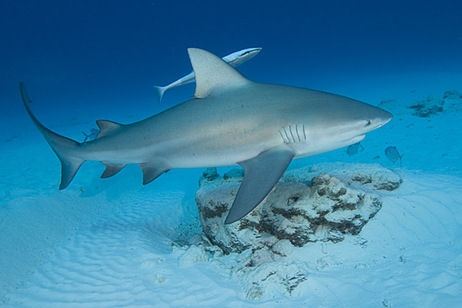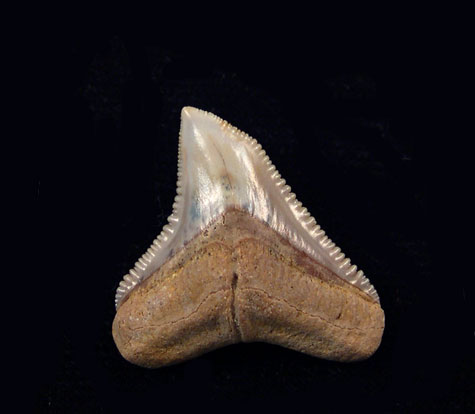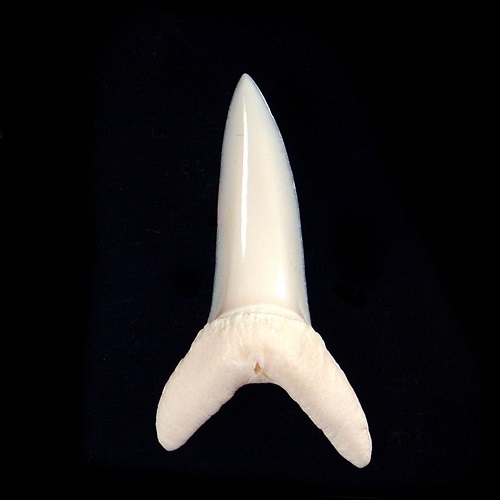Post by dinosauria101 on May 20, 2019 17:48:38 GMT 5
Bull Shark - Carcharhinus leucas
The bull shark, Carcharhinus leucas, also known as Zambezi shark or unofficially known as Zambi in Africa and Nicaragua shark in Nicaragua, is a shark common worldwide in warm, shallow waters along coasts and in rivers. The bull shark is well known for its unpredictable, often aggressive behavior. The Bull shark can thrive in both saltwater and freshwater and can travel far up rivers. They have even been known to travel as far up as Indiana in the Ohio River and Illinois in the Mississippi River, although there have been few recorded attacks. They are probably responsible for the majority of near-shore shark attacks, including many attacks attributed to other species. However, bull sharks are not true freshwater sharks (unlike the river sharks of the genus Glyphis). The name bull shark comes from the shark's stocky shapes, broad, flat snout and aggressive, unpredictable behavior. In India, the bull shark may be confused with the Sundarbans or Ganges shark. In Africa it is also commonly called the Zambezi River shark or just Zambi. Its wide range and diverse habitats result in many other local names, including Ganges River Shark, Fitzroy Creek Whaler, van Rooyen’s Shark, Lake Nicaragua Shark, river shark, freshwater whaler, estuary whaler, Swan River Whaler, cub shark, and shovelnose shark. Bull sharks are large and stout, with females being larger than males. Bull sharks are large and stout, with females being larger than males. The bull shark can be up to 81 cm (2.66 ft) in length at birth. Adult female bull sharks average 2.4 m (7.9 ft) long and typically weigh 130 kg (290 lb), whereas the slightly smaller adult male averages 2.25 m (7.4 ft) and 95 kg (210 lb). While a maximum size of 3.5 m (11 ft) is commonly reported, there is a questionable record of a female specimen of exactly 4 m (13 ft). The maximum recorded weight of a bull shark was 315 kg (690 lb) but may be larger. Bull sharks are wider than other requiem sharks of comparable length, and are grey on top and white below. The second dorsal fin is smaller than the first. Per the Discovery Channel and Animal Planet program Animal Face-Off, bull sharks have a bite force of up to 567 kilograms (1,250 lb). The bull shark's caudal fin is longer and lower than that of the larger sharks It also has a small snout. There is a lack of an interdorsal ridge. Bull sharks mate during late summer and early autumn, often in the brackish water of river mouths. After gestating for 12 months, a bull shark may give birth to four to ten live young. They are viviparous; they are born live and free-swimming. The young are about 70 cm (27.6 in) at birth and take 10 years to reach maturity. Coastal lagoons, river mouths, and other low-salinity estuaries are common nursery habitats.

Shortfin Mako Shark - Isurus oxyrinchus
The shortfin mako shark, Isurus oxyrinchus ("sharp nose"), is a large mackerel shark. Along with the closely related longfin mako (Isurus paucus) it is commonly referred to as a "mako shark". The shortfin mako inhabits offshore temperate and tropical seas worldwide. The closely related longfin mako shark, Isurus paucus, is found in the Gulf Stream or warmer offshore waters. The shortfin mako's speed has been recorded at 50 kilometres per hour (31 mph) with bursts of up to 74 kilometres per hour (46 mph). They can leap approximate 9 metres (30 ft) high or higher in the air. Some scientists suggest that the shortfin mako can swim up to 100 kilometres per hour (62 mph), though scientists are still in debate over exactly how fast the shortfin mako shark can swim. The shortfin mako feeds mainly upon cephalopods, bony fishes including mackerels, tunas, bonitos, and swordfish, but it may also eat other sharks, porpoises, sea turtles, and seabirds. The Shortfin Mako is a fairly large species of shark. An average adult specimen will measure around 3.2 m (10 ft) in length and weigh from 60–135 kg (130–300 lb). Females are larger than males. The largest "mako" taken (not verified between the two species) on hook-and-line was 505.8 kg (1,115 lb). Larger specimens are known, with a few large, mature females exceeding a length of 3.8 m (12 ft) and a weight of 570 kg (1,300 lb). The longest verified length for a Shortfin Mako caught off France in September 1973, was 4.45 m (14.6 ft). A specimen caught off of Italy, and examined in an Italian fish market in 1881, was reported to weigh an extraordinary 1,000 kg (2,200 lb) at a length of 4 m (13 ft).

Credit to Wikipedia
The bull shark, Carcharhinus leucas, also known as Zambezi shark or unofficially known as Zambi in Africa and Nicaragua shark in Nicaragua, is a shark common worldwide in warm, shallow waters along coasts and in rivers. The bull shark is well known for its unpredictable, often aggressive behavior. The Bull shark can thrive in both saltwater and freshwater and can travel far up rivers. They have even been known to travel as far up as Indiana in the Ohio River and Illinois in the Mississippi River, although there have been few recorded attacks. They are probably responsible for the majority of near-shore shark attacks, including many attacks attributed to other species. However, bull sharks are not true freshwater sharks (unlike the river sharks of the genus Glyphis). The name bull shark comes from the shark's stocky shapes, broad, flat snout and aggressive, unpredictable behavior. In India, the bull shark may be confused with the Sundarbans or Ganges shark. In Africa it is also commonly called the Zambezi River shark or just Zambi. Its wide range and diverse habitats result in many other local names, including Ganges River Shark, Fitzroy Creek Whaler, van Rooyen’s Shark, Lake Nicaragua Shark, river shark, freshwater whaler, estuary whaler, Swan River Whaler, cub shark, and shovelnose shark. Bull sharks are large and stout, with females being larger than males. Bull sharks are large and stout, with females being larger than males. The bull shark can be up to 81 cm (2.66 ft) in length at birth. Adult female bull sharks average 2.4 m (7.9 ft) long and typically weigh 130 kg (290 lb), whereas the slightly smaller adult male averages 2.25 m (7.4 ft) and 95 kg (210 lb). While a maximum size of 3.5 m (11 ft) is commonly reported, there is a questionable record of a female specimen of exactly 4 m (13 ft). The maximum recorded weight of a bull shark was 315 kg (690 lb) but may be larger. Bull sharks are wider than other requiem sharks of comparable length, and are grey on top and white below. The second dorsal fin is smaller than the first. Per the Discovery Channel and Animal Planet program Animal Face-Off, bull sharks have a bite force of up to 567 kilograms (1,250 lb). The bull shark's caudal fin is longer and lower than that of the larger sharks It also has a small snout. There is a lack of an interdorsal ridge. Bull sharks mate during late summer and early autumn, often in the brackish water of river mouths. After gestating for 12 months, a bull shark may give birth to four to ten live young. They are viviparous; they are born live and free-swimming. The young are about 70 cm (27.6 in) at birth and take 10 years to reach maturity. Coastal lagoons, river mouths, and other low-salinity estuaries are common nursery habitats.

Shortfin Mako Shark - Isurus oxyrinchus
The shortfin mako shark, Isurus oxyrinchus ("sharp nose"), is a large mackerel shark. Along with the closely related longfin mako (Isurus paucus) it is commonly referred to as a "mako shark". The shortfin mako inhabits offshore temperate and tropical seas worldwide. The closely related longfin mako shark, Isurus paucus, is found in the Gulf Stream or warmer offshore waters. The shortfin mako's speed has been recorded at 50 kilometres per hour (31 mph) with bursts of up to 74 kilometres per hour (46 mph). They can leap approximate 9 metres (30 ft) high or higher in the air. Some scientists suggest that the shortfin mako can swim up to 100 kilometres per hour (62 mph), though scientists are still in debate over exactly how fast the shortfin mako shark can swim. The shortfin mako feeds mainly upon cephalopods, bony fishes including mackerels, tunas, bonitos, and swordfish, but it may also eat other sharks, porpoises, sea turtles, and seabirds. The Shortfin Mako is a fairly large species of shark. An average adult specimen will measure around 3.2 m (10 ft) in length and weigh from 60–135 kg (130–300 lb). Females are larger than males. The largest "mako" taken (not verified between the two species) on hook-and-line was 505.8 kg (1,115 lb). Larger specimens are known, with a few large, mature females exceeding a length of 3.8 m (12 ft) and a weight of 570 kg (1,300 lb). The longest verified length for a Shortfin Mako caught off France in September 1973, was 4.45 m (14.6 ft). A specimen caught off of Italy, and examined in an Italian fish market in 1881, was reported to weigh an extraordinary 1,000 kg (2,200 lb) at a length of 4 m (13 ft).

Credit to Wikipedia







